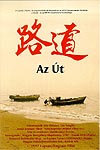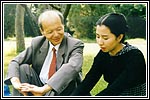 |
Vol 0, No 18
26 January 1999 |
|
|
 K I N O E Y E:
K I N O E Y E:Between Cultures, Between Documentary and Art Ferenc Moldovanyi's Az Ut Andrew J Horton Central Europe has long attracted attention issues raised by its minorities: Hungarians in Slovakia and Romania, Russians in the Baltics, Serbs in Croatia, and Roma everywhere, to give but a few examples. With so many different long-standing cultural mixes, it is interesting that Ferenc Moldovanyi should choose a totally different category of minority - namely the Chinese community in Budapest - as the basis for his most recent film Az Ut (The Way, 1997). Az Ut is what Moldovanyi describes as an attempt to find a "more soul-stirring, a more genuine reality." In doing this he has created a film whose feel lies totally within the realms of the artform whilst its subject-matter - a Chinese dissident living in Hungary - is documentary. Although Liu Zhixian has lived in Budapest for years he speaks no Hungarian (and consequently the film is in Chinese). An intellectual persecuted in the cultural revolution, his life has been a story of personal unhappiness and misfortune, and leaving China, whilst it has made his life easier, does not seem to have made it any more enjoyable. The film is his journey to try and reclaim some small inner pleasure in the closing days of his life and to make sense of the suffering he has experienced.
On top of this, he writes to his son Liu Yanghe back in China. Contrasting with his father's philosophical calm at the personal misery he has lived through, Liu Yanghe is torn by angst. He cannot take part in society and can only write his adolescent poetry and try to destroy himself. In between these two plots we learn more of Liu Zhixian's life in China: his first true love, his forced marriage to a working class girl and his eventual emigration. The three threads to his life weave around each other and although unconnected they do not detract from each other or spoil the feel of the film as a whole. The pace is slow and most of our information comes from Liu Zhixian's narration, with additional monologues from his son and very occasional dialogues. As we might expect of a Chinese work of art, the film is beautiful, pure and stripped of all superfluous drama, with the photography and the music being captivating in themselves.
Another view Az Ut is so perfectly filmed, it is hard to believe its origins. Moldovanyi creates an atmosphere which is totally immersed in its subject matter and the narrative, the pace and the visual style would seem to indicate that the director is Chinese. Although the main character lives in Budapest and the director is Hungarian, there is no compromise towards a Hungarian perspective of Liu Zhixian. Liu Zhixian makes no comment about the people whose country he chose to live in and there is no attempt to either romanticise or demonise Hungary and its culture. The Hungarian viewpoint is totally absent. This all raises the obvious question of why a Hungarian would want to make such a film. It might well be something to do with our ability to find faults with others easier than we find them with ourselves. Longing and desire exists in every society and neither China nor Hungary (and especially not post-1989 Hungary) is an exception. By focusing on his Chinese hero, Moldovanyi gives this longing - and the errors in life which follow from it - a universal feel. We can forgive Moldovanyi for berating us since he does so indirectly through the self-analysis Liu Zhixian applies to his life. It is hard not to be impressed with his wisdom and hard-earned experience of Liu Zhixian. His grandfatherly tone of voice is comforting and friendly and it is pleasant listening to its warm tones, even if you do not actually understand Chinese. In falling in love with Liu Zhixian a little, the audience can believe his self-criticism, comprehend the weight of it and take it on-board. Had Moldovanyi told a Hungarian story, we might have missed his point and felt less inclined to listen to his moral tale of longing for something you do not want or need. If such praises for the film's intellectual and aesthetic merits make it sound like a heavyweight, then I assure you it is my writing which is at fault and not the film. Az Ut is a wonderfully watchable film, although it took me five or ten minutes to slow my expectations down to its meditative pace. As with all good philosophical films, the premises do not weigh down on the plot and the story is amusing as much as it is enlightening. Andrew J Horton, 26 January 1999 Further Surfing Although Az Ut receives mentions on the websites of numerous international film festivals, there is little of any length and substance on the film. However, as luck would have it, what there is out there happens to be well worth reading. Gabor Gelencser's article "Detour" is a 1500- word analysis of Az Ut with specific attention to the relationship between documentary as fact and documentary as art, a thorny problem going all the way back to Dziga Vertov's Chelovek s kinoapparatom (Man with a Movie Camera, Russia, 1929). The article is also available in Hungarian. Gelencser's article appears in Filmkultura, a Hungarian film journal whose website is definitely worth checking out. The site features news, reviews, interviews and in-depth articles on both Hungarian film and film in Hungary, all available in English and Hungarian. Anyone wanting to look up any subject about any Central, South Eastern or Eastern European country, would be well advised to go to the Slavic Studies site for Hokkaido University. Film fans wanting information on Hungary are no exception (yes, I know Hungarians aren't Slavs - tell that to the university, not me). The site has no articles itself but provides a list of links to other articles and sources of information. They show their discerning eye for quality by including last year's Kinoeye article on avant-garde film and video in Hungary on their list.
|
|
![]()
Copyright (c) 1999 - Central Europe Review and Internet servis, a.s.
All Rights
Reserved
 His principal quest is to find a wife in his homeland and bring her to Hungary and, as a conversation with his hairdresser reveals, he has already spent considerable amounts of time and money failing in this endeavour. The girls he is introduced to by the agency he uses are too interested in his money and his Hungarian citizenship to be able to satisfy him and the relationships inevitably end disastrously. Recounting his woes to his hairdresser evokes both the tragedy and the comedy of these failed attempts to find happiness.
His principal quest is to find a wife in his homeland and bring her to Hungary and, as a conversation with his hairdresser reveals, he has already spent considerable amounts of time and money failing in this endeavour. The girls he is introduced to by the agency he uses are too interested in his money and his Hungarian citizenship to be able to satisfy him and the relationships inevitably end disastrously. Recounting his woes to his hairdresser evokes both the tragedy and the comedy of these failed attempts to find happiness. The film concludes when Liu Zhixian returns from a visit to China, which had the twin-purposes of seeing his son and meeting another young girl interested in marriage and, it transpires, in money. On the plane back, Liu Zhixian's narrative unexpectedly draws the three threads of his life together, unifying the thus-far disparate elements. In one short passage, a complex and unresolvable life is suddenly laid bare and the solutions to it become clear.
The film concludes when Liu Zhixian returns from a visit to China, which had the twin-purposes of seeing his son and meeting another young girl interested in marriage and, it transpires, in money. On the plane back, Liu Zhixian's narrative unexpectedly draws the three threads of his life together, unifying the thus-far disparate elements. In one short passage, a complex and unresolvable life is suddenly laid bare and the solutions to it become clear.